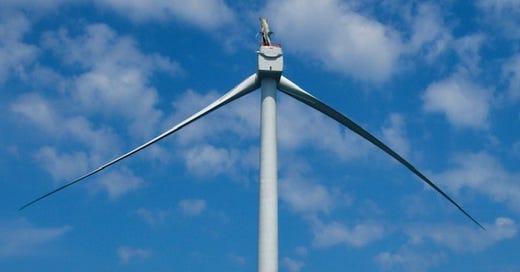Another Hazard of Wind Turbines Wherever They May Be: Their Affinity for Lightning
The frequency of lightning strikes on turbine blades is a two-way phenomenon that can cause them to fail and scatter their components far and wide.

Blighted turbine AW 38 at Vineyard Wind, the same one that lost an enormous blade last summer when portions fractured into thousands of pieces, was hit by lightning on February 28.
A statement by Vineyard Wind confirmed that lightning struck the still-remaining portion of the damaged blade, which was scheduled to be replaced in May. According to an email from a Coast Guard officer obtained by the Nantucket Current, the remaining blade piece “…caught fire and detached,” with no sign of debris.
With Vineyard Wind predictably downplaying the situation, it brings up a bigger issue: how often are wind turbines struck by lightning?
The short answer is all the time.
Upward and downward
Lightning strikes to wind turbine blades are so expected that lightning protection systems, monitoring, sensors, and ongoing analysis make up a separate industry within the industry.
Vaisala Xweather, a company that specializes in weather data and mapping revealed in its recent report that there were 77,494 lightning hits at or near wind farms in the U.S. Wind turbines are called “natural targets for lightning due to their height and use of conductive materials.”
And where very tall structures are concerned, NOAA tells how lightning can be “artificially initiated,” and go upward instead of the “normal” cloud-to-ground strike. “Upward triggered lightning,” it states, “usually occurs in response to a natural lightning flash, but on rare occasions can be ‘self-triggered’—usually in winter storms with strong winds.” In other words, the structure itself can produce upward lightning under the right circumstances of a “slowly increasing electric field…”
According to a published study on the topic of upward lightning, it’s much more destructive than downward lightning “due to the large charge transfer involved in the discharge process.”
Lightning strikes, upward or downward, even if they don’t immediately cause the blade to fall or catch fire, can lead to the deceptively innocuous term “blade failure.”
In reality, blades that have “failed” have been recorded as being flung up to a mile away. A 2023 study published in the journal Heliyon, tells that “blade pieces have gone through the roofs and walls of close buildings in Germany,” and advises that homes and businesses be at a minimum of a mile and a quarter away from wind turbines.
Statistically speaking, the company GCube, which describes itself as “renewable energy insurance experts” hasn’t provided any data on turbine blade failures since 2014. But at that time, they reported 700,000 blades in operation with a failure rate of 3,800 incidents a year.
Should Vineyard Wind 1 continue with its planned construction, there will soon be 62 turbines with 186 blades that have the same potential of being struck by lightning, creating lightning, catching fire, suffering blade failure, and launching themselves into the Atlantic.




As always, great and timely reporting, Linda. In Australia, they refer to the area 4km around an onshore turbine as the "kill zone". Onshore turbines are a lot shorter than the offshore monstrosities in our coastal waters, so one could assume that the entire offshore wind array is one gigantic kill zone. And not just for marine life and birds.
Another great article.
Fun fact ships get struck by lightning also, I was sailing on a fully loaded oil taker and witnessed it for myself, they are designed for it and I'm still here.